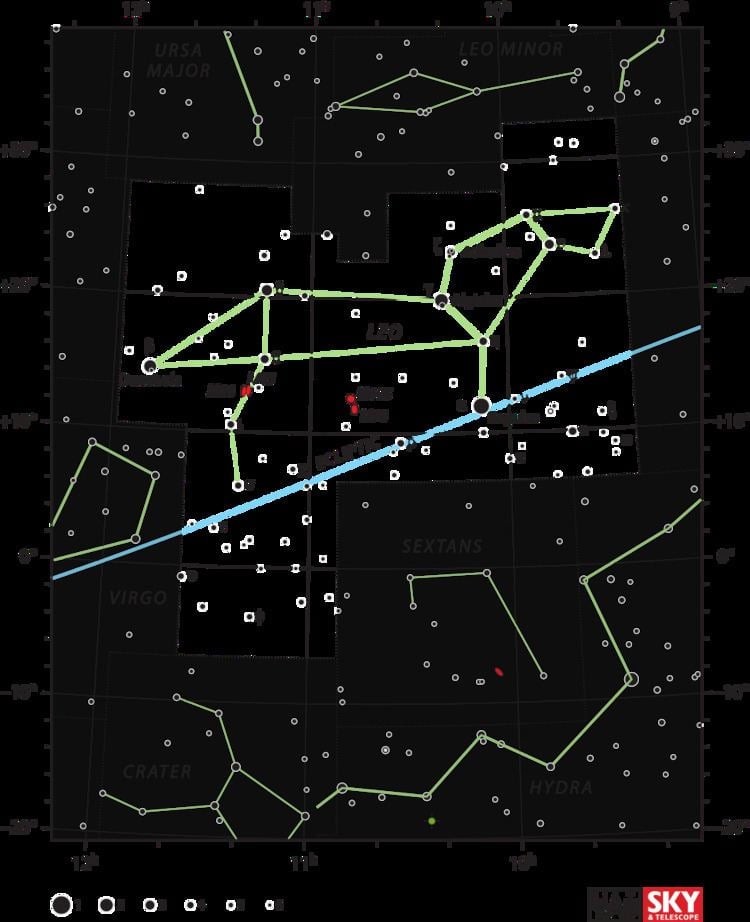Luminosity 40 L☉ | ||
 | ||
Gamma Leonis (γ Leonis, abbreviated Gamma Leo, γ Leo), also named Algieba, is a binary star system in the constellation of Leo. In 2009, a planetary companion around the primary was announced.
Contents
Nomenclature
γ Leonis (Latinised to Gamma Leonis) is the star's Bayer designation.
It also bore the traditional name Algieba or Al Gieba, which originated from the Arabic الجبهة Al-Jabhah, meaning 'the forehead' (despite this meaning, the star actually appears in the mane of Leo). In 2016, the International Astronomical Union organized a Working Group on Star Names (WGSN) to catalog and standardize proper names for stars. The WGSN's first bulletin of July 2016 included a table of the first two batches of names approved by the WGSN; which included Algieba for this star.
The star's traditional Latin name was Juba. It is known as 軒轅十二 (the Twelfth Star of Xuanyuan) in Chinese (Xuanyuan is the name of the Yellow Emperor).
Algieba (gamma), Adhafera (Zeta Leonis), and Al Jabbah (Eta Leonis) have collectively been called 'the Sickle', which is an asterism formed from the head of Leo.
Stellar system
The bright binary system in Leo with orange-red and yellow or greenish-yellow components is visible through a modest telescope under good atmospheric conditions. To the naked eye, the Algieba system shines at mid-second magnitude, but a telescope easily splits the pair. The brighter component has an apparent magnitude of +2.28 and is of spectral class K1-IIIbCN-0.5. The giant K star has a surface temperature of 4,470 K, a luminosity 180 times that of the Sun, and a diameter 23 times that of the Sun. The companion star has an apparent magnitude of +3.51 and belongs to the spectral class G7IIICN-I. The giant G star has a temperature of 4,980 K, a luminosity of 50 times that of the Sun, and a diameter 10 times that of the Sun. With angular separation of just over 4", the two stars are at least 170 AU apart (four times the distance between the Sun and Pluto), and have an orbital period of over 500 years. Because the orbital period is so long, only a fraction of the full path has been observed since discovery.
Both stars are almost certainly true giants, meaning that they have stopped fusing hydrogen to helium in their cores and have expanded to great proportions. Although there has been too little observation of their orbit to calculate their masses, comparison with evolutionary calculations suggests that each are about double the mass of the Sun. Originating from the same interstellar cloud some two billion years ago, the stars have iron contents about a third that of the Sun. It is hard to tell how far along they might be in their life cycle. They both may be fusing helium in their cores, or they could be giants in development, with quiet helium cores that are waiting to fire up. The chemical composition at the surface, which is influenced by age, suggests the former.
Planetary system
On November 6, 2009, the discovery of a planetary companion around primary star Gamma-1 Leonis was announced. The radial velocity measurements suggest two additional periodicities of 8.5 and 1340 days. The former is likely due to stellar pulsation, whereas the latter could be indicative of the presence of an additional planetary companion with 2.14 Jupiter masses, moderate eccentricity (e=0.13) and located at 2.6 Astronomical Units away from the giant star. Nevertheless, the nature of such a signal is still unclear and further investigations are needed to confirm or rule out an additional substellar companion.
